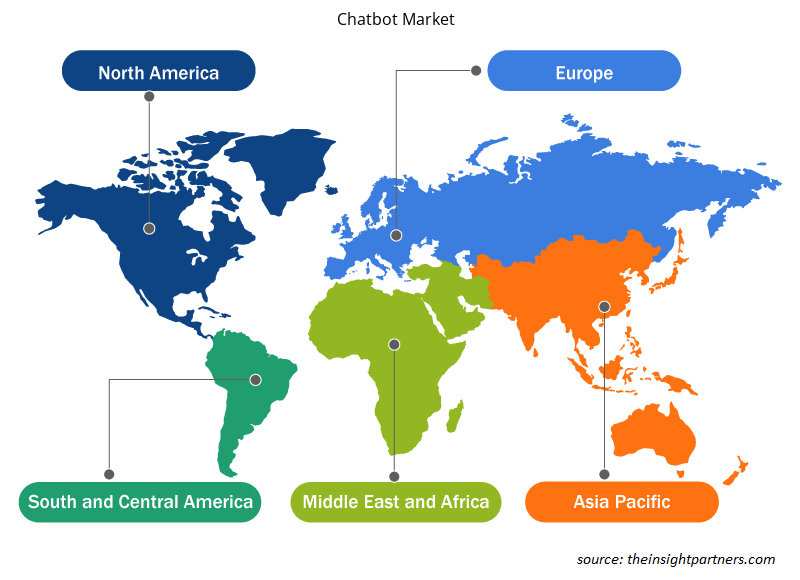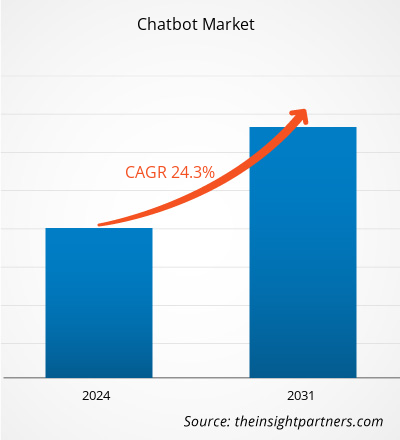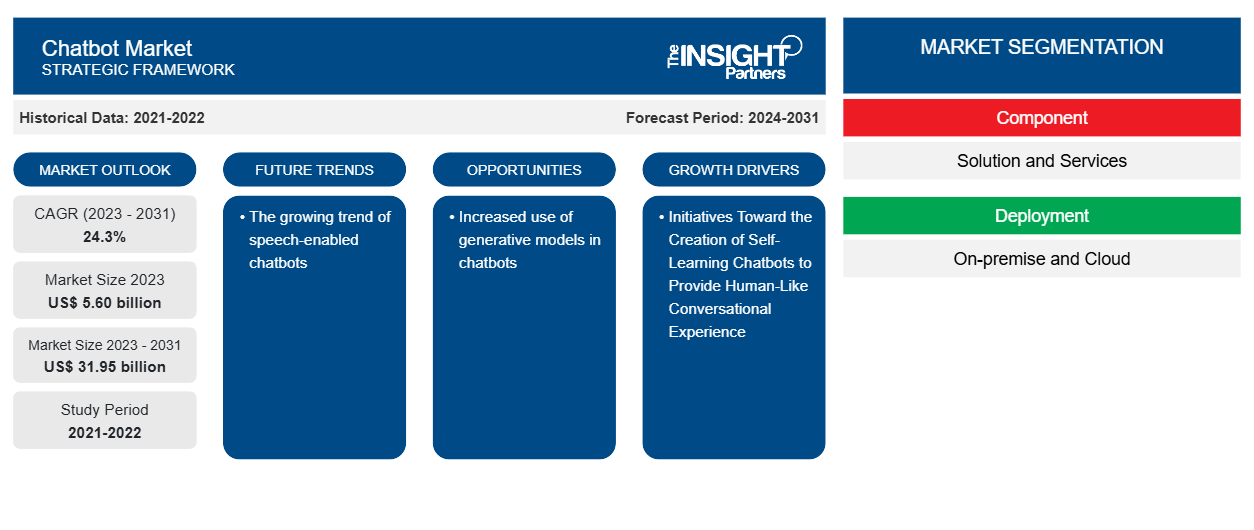Se proyecta que el tamaño del mercado de chatbots alcance los 31.950 millones de dólares en 2031, frente a los 5.600 millones de dólares en 2023. Se espera que el mercado de chatbots registre una CAGR del 24,3 % entre 2023 y 2031. El mercado está impulsado principalmente por el creciente dominio de las aplicaciones de mensajería y la creciente demanda de análisis de clientes.
Análisis del mercado de chatbots
Los modelos generativos pueden mejorar las habilidades de procesamiento del lenguaje natural (PLN) de los chatbots, lo que lleva a una mejor comprensión y respuesta al lenguaje humano. Los modelos generativos, como GPT-4, pueden mejorar la comprensión de los chatbots de las preferencias y los hábitos de los usuarios, lo que permite recomendaciones y asistencia más personalizadas. Debido a la creciente popularidad de las aplicaciones de mensajería, la integración de chatbots con mensajería produce un mayor retorno de la inversión porque dirigirse a los clientes a través de su aplicación preferida mejora la experiencia del usuario.
Descripción general del mercado de chatbots
El mercado de los chatbots ha crecido significativamente en los últimos años. La necesidad de proporcionar un servicio de atención al cliente las 24 horas del día, los 7 días de la semana y reducir los costes operativos delegando tareas a los chatbots, así como el aumento del deseo de los clientes de realizar operaciones de autoservicio, han contribuido a aumentar la demanda. Esto puede estar relacionado con la creciente preferencia de las personas por las aplicaciones de mensajería en lugar de los sitios de redes sociales. Asimismo, se prevé que los chatbots diseñados para la integración con las aplicaciones de mensajería tengan una gran demanda en el mercado en el futuro. Además, los chatbots están ganando popularidad a medida que las organizaciones se esfuerzan por automatizar sus ventas y atención al cliente. El uso de chatbots permite a las empresas proporcionar servicios oportunos a un menor coste.
Personalice este informe según sus necesidades
Obtendrá personalización en cualquier informe, sin cargo, incluidas partes de este informe o análisis a nivel de país, paquete de datos de Excel, así como también grandes ofertas y descuentos para empresas emergentes y universidades.
-
Obtenga las principales tendencias clave del mercado de este informe.Esta muestra GRATUITA incluirá análisis de datos, desde tendencias del mercado hasta estimaciones y pronósticos.
Impulsores y oportunidades del mercado de chatbots
Mayor uso de modelos generativos en chatbots para favorecer el mercado
Recientemente, la IA ha experimentado avances considerables, en particular en torno a la IA generativa y los LLM. Los modelos basados en aprendizaje profundo generan contenido nuevo al identificar patrones en grandes conjuntos de datos. El chatbot de OpenAl, ChatGPT, utiliza el modelo de lenguaje GPT-3.5 para generar prosa similar a la humana que reconoce el contexto. Además de convertir texto a texto, la IA generativa también puede convertir imágenes, videos , modelos 3D, música y más. La IA generativa permite a las empresas generar ideas únicas para productos, servicios y soluciones de manera más rápida y eficiente. La IA generativa proporciona a las organizaciones conocimiento basado en datos para una toma de decisiones informada y reduce los gastos relacionados con el desarrollo de productos y los ciclos de marketing.
Iniciativas para la creación de chatbots autodidactas que proporcionen una experiencia conversacional similar a la humana
Los chatbots pueden adaptarse a entornos cambiantes y aprender de sus acciones, experiencias y conclusiones. Los chatbots analizan datos rápidamente y brindan asistencia en muchos idiomas, lo que facilita que los clientes encuentren la información que necesitan. Los bots de autoaprendizaje utilizan comportamientos basados en datos, tecnología de procesamiento del lenguaje natural y aprendizaje automático supervisado para brindar una comunicación más natural. Pueden aprender de sus errores. Se están realizando varios esfuerzos para la creación de chatbots de autoaprendizaje. Los chatbots de autoaprendizaje ofrecen respuestas personalizadas y apropiadas, mejorando la experiencia del consumidor. El chatbot continúa aprendiendo de las interacciones del usuario.
Análisis de segmentación del informe de mercado de chatbots
Los segmentos clave que contribuyeron a la derivación del análisis del mercado de chatbot son los componentes, la implementación, el tamaño de la organización que los utiliza y el usuario final.
- Según el componente, el mercado de chatbot se segmenta en soluciones y servicios.
- Según la implementación, el mercado de chatbots se segmenta en local y en la nube.
- Según el uso, el mercado de chatbots se segmenta en sitios web, centros de contacto, redes sociales y plataformas móviles.
- Según el usuario final, el mercado de chatbot se segmenta en educación, comercio minorista y comercio electrónico, BFSI, atención médica, viajes y turismo, y otros.
Análisis de la cuota de mercado de los chatbots por geografía
El alcance geográfico del informe de mercado de chatbots se divide principalmente en cinco regiones: América del Norte, Asia Pacífico, Europa, Oriente Medio y África, y América del Sur/América del Sur y Central. Asia Pacífico está experimentando una tremenda industrialización, lo que aumenta la demanda de chatbots en el mercado. Las crecientes industrias minoristas y de comercio electrónico en países en ascenso como China, India, Indonesia, Vietnam, Malasia, Filipinas y Tailandia han acelerado la alta demanda y la aceptación generalizada de los chatbots entre los comerciantes y los propietarios de empresas de comercio electrónico .
Perspectivas regionales del mercado de chatbots
Los analistas de Insight Partners explicaron en detalle las tendencias y los factores regionales que influyen en el mercado de chatbots durante el período de pronóstico. Esta sección también analiza los segmentos y la geografía del mercado de chatbots en América del Norte, Europa, Asia Pacífico, Oriente Medio y África, y América del Sur y Central.

- Obtenga datos regionales específicos para el mercado de chatbots
Alcance del informe de mercado de chatbots
| Atributo del informe | Detalles |
|---|---|
| Tamaño del mercado en 2023 | 5.600 millones de dólares estadounidenses |
| Tamaño del mercado en 2031 | 31.950 millones de dólares estadounidenses |
| CAGR global (2023 - 2031) | 24,3% |
| Datos históricos | 2021-2022 |
| Período de pronóstico | 2024-2031 |
| Segmentos cubiertos |
Por componente
|
| Regiones y países cubiertos |
América del norte
|
| Líderes del mercado y perfiles de empresas clave |
|
Densidad de actores del mercado de chatbots: comprensión de su impacto en la dinámica empresarial
El mercado de chatbots está creciendo rápidamente, impulsado por la creciente demanda de los usuarios finales debido a factores como la evolución de las preferencias de los consumidores, los avances tecnológicos y una mayor conciencia de los beneficios del producto. A medida que aumenta la demanda, las empresas amplían sus ofertas, innovan para satisfacer las necesidades de los consumidores y aprovechan las tendencias emergentes, lo que impulsa aún más el crecimiento del mercado.
La densidad de actores del mercado se refiere a la distribución de las empresas o firmas que operan dentro de un mercado o industria en particular. Indica cuántos competidores (actores del mercado) están presentes en un espacio de mercado determinado en relación con su tamaño o valor total de mercado.
Las principales empresas que operan en el mercado de Chatbot son:
- Servicios web de Amazon
- Soluciones artificiales
- Sociedad Anónima Creativa Virtual Pvt. Ltd.
- Empresa de experiencia del cliente
- Corporación eGain
- Corporación IBM
Descargo de responsabilidad : Las empresas enumeradas anteriormente no están clasificadas en ningún orden particular.

- Obtenga una descripción general de los principales actores clave del mercado de Chatbot
Noticias y desarrollos recientes del mercado de chatbots
El mercado de chatbots se evalúa mediante la recopilación de datos cualitativos y cuantitativos a partir de investigaciones primarias y secundarias, que incluyen publicaciones corporativas importantes, datos de asociaciones y bases de datos. A continuación, se incluye una lista de novedades en el mercado:
- En abril de 2023, Zendesk se asoció con OpenAI, un importante laboratorio de investigación de inteligencia artificial con sede en Estados Unidos. La empresa brindaría a sus usuarios soluciones respaldadas por inteligencia artificial para simplificar las actividades de generación de tickets para los empleados de CX y atención al cliente. Zendesk y OpenAI están trabajando juntos para mejorar las capacidades de los modelos básicos de Zendesk, que son propietarios, integrándolos con los de OpenAI.
(Fuente: Zendesk, Nota de prensa, 2021)
- En enero de 2023, Kore.ai anunció que lanzará RetailAssist, una solución de asistente de ventas conversacional para la industria minorista, en la exposición de la Federación Nacional de Minoristas (NRF 2023) en la ciudad de Nueva York.
(Fuente: Kore.ai, comunicado de prensa, 2023)
Informe de mercado sobre chatbots: cobertura y resultados
El informe "Tamaño y pronóstico del mercado de chatbots (2021-2031)" proporciona un análisis detallado del mercado que cubre las siguientes áreas:
- Tamaño del mercado y pronóstico a nivel global, regional y nacional para todos los segmentos clave del mercado cubiertos bajo el alcance
- Dinámica del mercado, como impulsores, restricciones y oportunidades clave
- Principales tendencias futuras
- Análisis detallado de las cinco fuerzas de Porter y PEST y FODA
- Análisis del mercado global y regional que cubre las tendencias clave del mercado, los principales actores, las regulaciones y los desarrollos recientes del mercado.
- Análisis del panorama de la industria y de la competencia que abarca la concentración del mercado, el análisis de mapas de calor, los actores destacados y los desarrollos recientes
- Perfiles detallados de empresas
- Análisis histórico (2 años), año base, pronóstico (7 años) con CAGR
- Análisis PEST y FODA
- Tamaño del mercado, valor/volumen: global, regional y nacional
- Industria y panorama competitivo
- Conjunto de datos de Excel
Informes recientes
Testimonios
Razón para comprar
- Toma de decisiones informada
- Comprensión de la dinámica del mercado
- Análisis competitivo
- Información sobre clientes
- Pronósticos del mercado
- Mitigación de riesgos
- Planificación estratégica
- Justificación de la inversión
- Identificación de mercados emergentes
- Mejora de las estrategias de marketing
- Impulso de la eficiencia operativa
- Alineación con las tendencias regulatorias























 Obtenga una muestra gratuita para - Mercado de chatbots
Obtenga una muestra gratuita para - Mercado de chatbots